语言学基本定义
- 格式:doc
- 大小:41.50 KB
- 文档页数:9

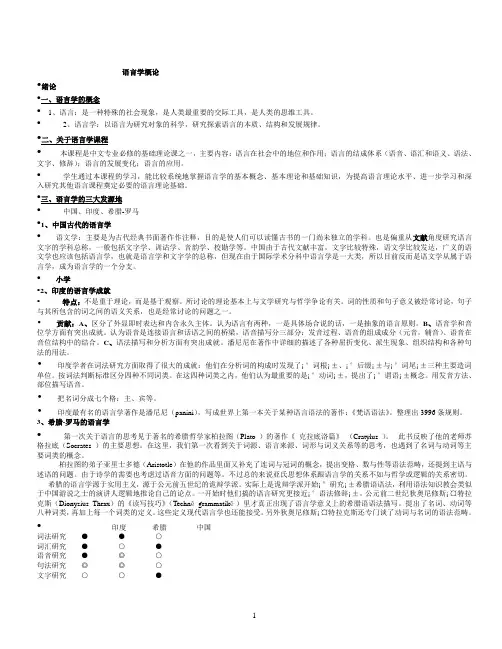
语言学概论•绪论•一、语言学的概念•1、语言:是一种特殊的社会现象,是人类最重要的交际工具,是人类的思维工具。
•2、语言学:以语言为研究对象的科学,研究探索语言的本质、结构和发展规律。
•二、关于语言学课程•本课程是中文专业必修的基础理论课之一,主要内容:语言在社会中的地位和作用;语言的结成体系(语音、语汇和语义、语法、文字、修辞);语言的发展变化;语言的应用。
•学生通过本课程的学习,能比较系统地掌握语言学的基本概念、基本理论和基础知识,为提高语言理论水平、进一步学习和深入研究其他语言课程奠定必要的语言理论基础。
•三、语言学的三大发源地•中国、印度、希腊-罗马•1、中国古代的语言学•语文学:主要是为古代经典书面著作作注释,目的是使人们可以读懂古书的一门尚未独立的学科。
也是偏重从文献角度研究语言文字的学科总称,一般包括文字学、训诂学、音韵学、校勘学等。
中国由于古代文献丰富,文字比较特殊,语文学比较发达,广义的语文学也应该包括语言学,也就是语言学和文字学的总称,但现在由于国际学术分科中语言学是一大类,所以目前反而是语文学从属于语言学,成为语言学的一个分支。
•小学•2、印度的语言学成就•特点:不是重于理论,而是基于观察。
所讨论的理论基本上与文学研究与哲学争论有关。
词的性质和句子意义被经常讨论,句子与其所包含的词之间的语义关系,也是经常讨论的问题之一。
•贡献:A、区分了外显即时表达和内含永久主体。
认为语言有两种,一是具体场合说的话,一是抽象的语言原则。
B、语音学和音位学方面有突出成就。
认为语音是连接语言和话语之间的桥梁,语音描写分三部分:发音过程、语音的组成成分(元音,辅音)、语音在音位结构中的结合。
C、语法描写和分析方面有突出成就。
潘尼尼在著作中详细的描述了各种屈折变化、派生现象、组织结构和各种句法的用法。
•印度学者在词法研究方面取得了很大的成就:他们在分析词的构成时发现了¡°词根¡±、¡°后缀¡±与¡°词尾¡±三种主要造词单位。
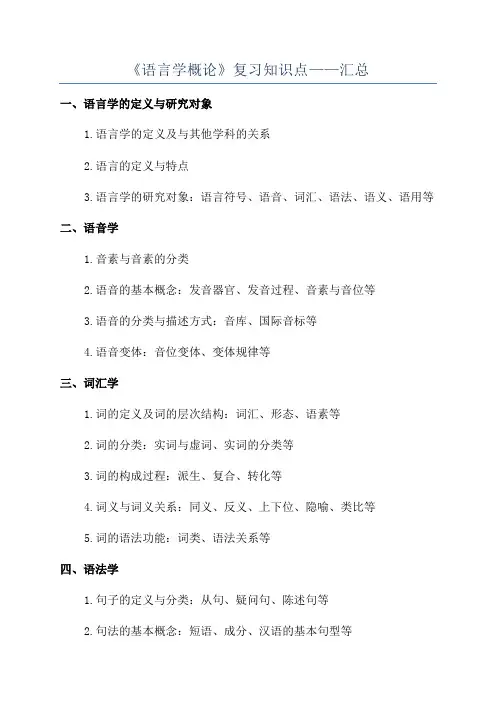
《语言学概论》复习知识点——汇总一、语言学的定义与研究对象1.语言学的定义及与其他学科的关系2.语言的定义与特点3.语言学的研究对象:语言符号、语音、词汇、语法、语义、语用等二、语音学1.音素与音素的分类2.语音的基本概念:发音器官、发音过程、音素与音位等3.语音的分类与描述方式:音库、国际音标等4.语音变体:音位变体、变体规律等三、词汇学1.词的定义及词的层次结构:词汇、形态、语素等2.词的分类:实词与虚词、实词的分类等3.词的构成过程:派生、复合、转化等4.词义与词义关系:同义、反义、上下位、隐喻、类比等5.词的语法功能:词类、语法关系等四、语法学1.句子的定义与分类:从句、疑问句、陈述句等2.句法的基本概念:短语、成分、汉语的基本句型等3.句法关系与句法结构:并列、从属、修饰等4.句法规则与句法分析:形式语法、语义角度的句法分析等5.语法现象的分析与解释:形式语法与功能语法的对比、语法规则、语法的普遍性、语法的可及性等五、语义学1.语义的定义与特点2.词义的构成与分类:词汇意义、语法意义、逻辑意义、上下文意义等3.语义关系与语义角色:同义、反义、上下位、隐喻、类比、关联等4.语义现象的分析与解释:语义成分的划分与关系、语义的可及性、语义的派生与转化等六、语用学1.语用学的定义与研究领域2.语言交际与语言交际行为:意图、目的、合作原则等3.言外之意与言外之行:言外之意的表示方式、言外之行的示例等4.语用现象的分析与解释:语言行为、语用规则、语用的多样性等七、语言学研究方法与分支学科1.语言学研究的方法论:描述性研究、实证研究等2.语言学的分支学科:应用语言学、对比语言学、历史语言学、社会语言学等3.参考书目和领域动态:《现代语言学导论》、《实用语义学》、《语法学》等这些都是《语言学概论》中的重要知识点,希望以上内容对您的复习有所帮助。
![语言学教程[第一章语言学导论]山东大学期末考试知识点复习](https://uimg.taocdn.com/948fb3732b160b4e777fcf0b.webp)
第一章语言学导论复习笔记Ⅰ.语言的定义语言是人类以口头交流的任意的符号系统。
该定义揭示了语言的五个要素:系统,任意,口头,符号,人类。
Ⅱ.语言的定义特征语言的定义特征是人类语言区别于其他动物交流系统的特点。
1.任意性任意性是语言的核心特征,是指符号的形式或者声音与意义之间没有逻辑或内在联系。
虽然语言从本质上讲是任意的,但也不是完全任意的。
一些词语,例如一些拟声词的发音与其意义还是有一定联系的。
2.二重性二重性是指拥有两层结构的这种属性,底层结构是上层结构的组成成分,每层都有自身的组合规则。
二重性只存在于这样的系统之中,既有元素又有它们组合成的单位。
3.创造性创造性指语言的能产性,它能够使人造出和理解无穷的长句,其中很多句子是以前从未听过的。
4.移位性移位性是指人类语言可以让使用者在交际时用语言符号代表时间上和空间上并不可及的物体、事件和观点。
移位性赋予人们的概括和想象力使人类受益无穷。
5.文化传递性语言不是靠遗传,而是通过文化传递的。
6.互换性互换性是指人可以是信息的发出者,也可以是信息的接受者,即人作为说话者和听话者的角色是可以随意更换的。
Ⅲ.语言的起源1.圣经的记载语言是上帝的恩赐。
2.“汪汪”理论语言是模仿自然的声音,例如动物的叫声,如 (鸭子)的刮刮声,嘎嘎声,布谷鸟的叫声。
3.“噗噗”理论语言来源于人本能的情感声音,表达疼痛或喜悦。
4.“哟一嘿一吼”理论语言起源于原始人共同劳动时发出的有节奏的哼哟声。
5.进化理论语言起源于劳动的过程,满足了社会的需求。
Ⅳ.语言的功能1.信息功能语言用来陈述某件事情,提供信息或用作推理。
信息功能是语言最重要的功能,一般出现在陈述句中。
2.人际功能人际功能是语言最重要的社会功能。
人们由此建立和维持他们的身份和社会地位。
3.施为功能语言的施为功能主要是用来改变人的社会地位,例如在婚礼、判刑,为孩子祈福和在首航仪式上为船命名、诅咒敌人。
在这些言语行为中,语言通常是非常正式的,甚至是仪式化的。
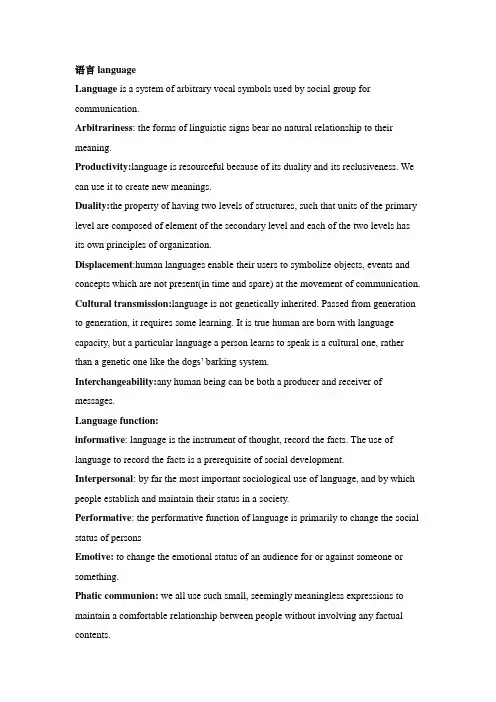
语言languageLanguage is a system of arbitrary vocal symbols used by social group for communication.Arbitrariness: the forms of linguistic signs bear no natural relationship to their meaning.Productivity:language is resourceful because of its duality and its reclusiveness. We can use it to create new meanings.Duality:the property of having two levels of structures, such that units of the primary level are composed of element of the secondary level and each of the two levels has its own principles of organization.Displacement:human languages enable their users to symbolize objects, events and concepts which are not present(in time and spare) at the movement of communication. Cultural transmission:language is not genetically inherited. Passed from generation to generation, it requires some learning. It is true human are born with language capacity, but a particular language a person learns to speak is a cultural one, rather than a genetic one like the dogs’ barking system.Interchangeability:any human being can be both a producer and receiver of messages.Language function:informative: language is the instrument of thought, record the facts. The use of language to record the facts is a prerequisite of social development. Interpersonal: by far the most important sociological use of language, and by which people establish and maintain their status in a society.Performative: the performative function of language is primarily to change the social status of personsEmotive: to change the emotional status of an audience for or against someone or something.Phatic communion: we all use such small, seemingly meaningless expressions to maintain a comfortable relationship between people without involving any factual contents.Recreational: the recreational function of a language is often overlooked because it seems so restrictive in purpose and supposedly so limited in usefulness. Metalingual: our language can be used to talk about itself.Sociolinguistics—the study of language with reference to society. Psycholinguistics---the study of language with reference to the working of the mind. Applied linguistics---the application of linguistic principles and theories to language teaching and learning.Important distinctions in linguistics: 规定性Prescriptive .描述性Descriptive /8.共时语言学Synchronical linguistics 7.历时语言学Diachronic linguistics /5.语言能力Competence 6.语言运用performance /9.语言langue 10.言语parole /speech, writing/ traditional grammar and modern linguistics第二章音系学1 Phonologyis the study of the sound patterns and sound systems of languages. It aims to discover the principles that govern the way sounds are organized in languages, and to explain the variations that occur.2 international phonetic alphabetA set of standard phonetic symbols in the form of a chart, designed by the international phonetic association since 1888. It has been revised from time to time to include new discoveries and changes in phonetic theory and practice.3 consonants and vowelsConsonant are produced by a closure in the vocal tract, or by a narrowing, which is so marked that air can not escape without producing audible friction.V owel is produced without such stricture so that air escapes in a relatively unimpeded way through the mouth or nose.4 cardinal vowelAre a set of vowel qualities arbitrarily defined, fixed and unchanging, intended to provide a frame of reference for the description of the actual vowels of existing language.5 anticipatory and perseverative co-articulationwhen such simultaneous or overlapping articulation are involved, we call the process co-articulation.If the sound becomes more like the following sound, it is known as anticipatoryco-articulation. If the sound shows the influence of the proceeding sound,it is perseverative co-articulation.6PhonemeThe smallest of sound which can distinguish two words7AllophonesDifferent phones which can represent a phoneme in different environments are called the allophones of that phoneme.8Minimal pairAre two words in a language which differ from each other by only one distinctive sound and which also differ in meaning.9free variationif two sounds occurring in the same environment do not contrast, that is the substitution of one for the other does not produce a different word form, but merely a different pronunciation of the same word, then the two words are in free variation. Chapter three 词汇学The total number of words stored in the brain is called the lexicon.Words are the smallest free units of language that unite sounds with meaning.Word :A unit of expression that has universal intuitive recognition by native speakers, whether it is expressed in spoken or written form.Lexeme: the abstract unit underlying the smallest unit in the lexical system of a language, which appears in different grammatical contexts.Grammatical/Functional words: express grammatical meanings, such as conjunctions, prepositions, articles, pronouns.Lexical/content words: have lexical meanings, those which refer to substance, action and quality, such as nouns, verbs, adjectives, and adverbs.Open-class words: a word group whose membership is in principle in finite or unlimited. New members can be added.Closed-class words: a word group whose membership is fixed or limited, new members are not regularly added.Morphology; the study of word formation, the internal structure of words, and the rules by which words are formed.Morphemes: the smallest unit language in terms of relationship between expression and content, a unit that cannot be further divided into smaller units without destroying or drastically altering the meaning, whether it is lexical or grammatical.Free morphemes: those that may constitute words by themselves.Bound morphemes;those that can not occur aloneRoot: the base form of a word that cannot be further analyzed without total loss of identity. It is that part of a word-form that remains when all the inflectional affixes and derivational affixes have been removed.Affix: the types of formative/morpheme that can be used only when added to another morpheme.Base: any form to which affixes of any kind can be added; a form to which a rule of word formation is applied.Stem: the part of the word form which remains when all inflectional affixes have been removed.Inflection: indicates grammatical relations by adding inflectional affixes. Derivation: combination of an existing word and an affix to form a new word. Compounding/composition is word-formation process consisting of joining two or more bases to form a new unit, a compound word-An Introduction to Modern Linguistics.Endocentric: one element serves as the head, of same syntactic class as the whole the relationship of ‘a kind of’.Exocentric: there is no head, no elements is of the same syntactic class as the whole, so not a relationship of ‘a kind of ‘something.Derivation: is also called ‘affixation’. It is the morphological process whereby grammatical of lexical information is added to the base.Conversion: is a word-formation process by which a word is altered from one part of speech to anther without the addition or deletion of any morpheme.Allomorph: some morphemes have a single form in all contexts. But a morpheme may have considerable variations, alternate shapes or phonetic forms called the allomorph.Blending: a process of word-information in which a new word is formed by combining the meanings and sounds of two words, one of which is not in its full form or both of which are not in their full forms.Back-formation: a shorter word is derived by deleting an imagined affix from a longer form already in the language.Acronym: words formed from the initial letters of the name of an organization or scientific term, etc. it differs from initialisms in that they are pronounced as words rather than as sequence of letter.Initialism: a type of shortening, using the first letter of words to form a proper name, a technical term, or phrase; an initialism is pronounced letter by letter.Analogical creation: It can account for the coexistence of two forms, regular and irregular, I the conjugation of some English verbs.Loanwords: both form and meaning are borrowed with only a slight adaptation. Loanblend: part of the form is native and part is borrowed, but the meaning is fully borrowed.Chapter 4 syntaxSyntax: the study of the rules governing the way words are combined to form sentences in a language, or simply the study of the formation of sentences. Category: the term category in some approaches refers to classes and functions in its narrow sense. More specifically, it refers to the defining properties of these general units.Phrase: is a single element of structure containing more than one word, and lacking the subject-predicate structure typical of clause.Word group is an extension of word of a particular class by way of modification with its main features of the class unchanged.Clause: a constituent with its own subjects and predicate when it is included in a lager sentence.Syntagmatic is a relation between one item and others in a sequence or between elements which are all present.Paradigmatic relation refers to classes or sets of words substitutable for each other grammatically in sentences with the same structure.grammatical construction; any syntactic construct which is assigned one or more conventional functions in a language, together with whatever is linguistically conventionalized about its contribution to the meaning or use the construct contains. constituent is a term used in structural sentence analysis for every linguistic unit, which is a part of a larger linguistic unit. Several constituents together form a construction.An endocentric construction is one whose distribution is functionally equivalent to one of its constituents, which serves as the center or head of the whole.Exocentric construction refers to a group of syntactically related words where none of the words is functionally equivalent to the group as a whole, that is, there is no definable “Centre” or “Head” inside the group, usually including the basic sentence, the prepositional phrase, the predicate construction, and the connective construction. Subordinate construction those in which there is only one head, with the head being dominant and the other constituents dependent,Coordinate construction:there are more than one head, the head can stand for the original construction functionally.Deep structure: the abstract representation of the syntactic properties of a constructionSurface structure: the final stage in syntactic derivation of a construction.Chapter five SemanticsDenotation involves the relationship between a linguistic unit and the non-linguistic entities to which it refers. Thus it is equivalent to referential meaning. Connotation-opposite to denotation, means the properties of the entity a word denotes.Sense be defined as the semantics relations between one word and another, or more generally between the one linguistic unit and another.Reference: is concerned with the relation between a word and the thing it refers to , or more generally between a linguistic unit and non-linguistic entity it refers to. Synonymy-refers to the sameness or close similarity of meaningAntonymy-oppositeness of meaning.Complementary antonymy-the denial of one member of the pair implies the assertion of the other.Converse/reversal antonyms/relational opposites-exhibits the reversal of the relationship between the two items, one presupposes the other.Hyponymy上下义-inclusiveness, a relation of inclusion Compositionality-the idea that the meaning of a sentence depends on the meaning of the constitute words and the way they are combined-the principle of compositionality.Polysemy一次多义-the same one word may have more than one meaning. Homonymy同音同形异义-the phenomenon that words having different meaning have the same form.Conceptual meaning-leech defined as the logical, cognitive, or denotative content. In other words, it overlaps to a large extent with the notion of reference.Linguistic semantics-the study of the meaning of linguistic units, words and sentences in particularPropositional logic-it is also know as propositional calculus or sentential calculus, is the study of the truth conditions for propositionsProposition-is expressed by a declarative sentence when that sentence is uttered to make a statement.。

定义 1.语言学Linguistics is generally defined as the scientific study of language.2.语言Language is a system of arbitrary vocal symbols used for human communication.语言是人类用来交际的任意性的有声符号体系。
4.识别特征Design Features It refers to the defining poperties of human language that distinguish it from any animal system of communication.语言识别特征是指人类语言区别与其他任何动物的交际体系的限定性特征。
Arbitrariness任意性Productivity多产性Duality双重性Displacement移位性Cultural transmission文化传递⑴arbitrariness There is no logical connection between meanings and sounds.P.S thearbitrary nature of language is a sign of sophistication and it makes it possible for language to have an unlimited source of expressions⑵Productivity Animals are quite limited in the messages they are able to send.⑶Duality Language is a system,which consists of two sets of structures,or two levels.⑷Displacement Language can be used to refer to contexts removed from the immediate situations of the speaker.⑸Cultural transmission Human capacity for language has a genetic basis,but we have to be taught and learned the details of any language system.this showed that language is culturally transmitted.not by instinct.animals are born with the capacity to produce the set of calls peculiar to their species.5.语言能力Competence is the ideal user’s knowledge of the rules of his language.6.语言运用Performance is the actual realization of this knowledge in linguistic communication.语言运用是所掌握的规则在语言交际中的体现。


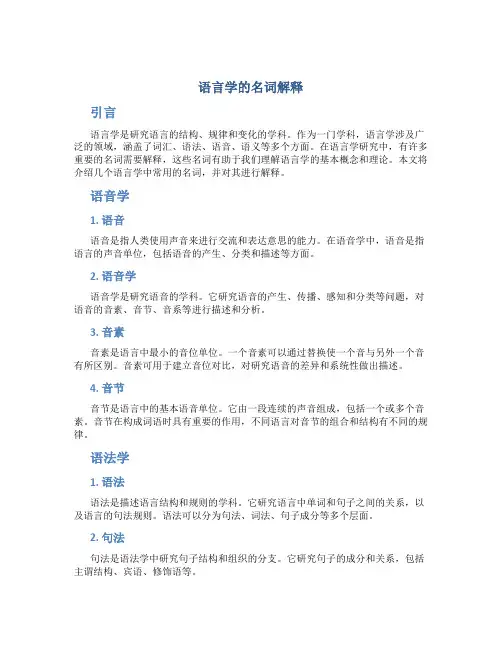
语言学的名词解释引言语言学是研究语言的结构、规律和变化的学科。
作为一门学科,语言学涉及广泛的领域,涵盖了词汇、语法、语音、语义等多个方面。
在语言学研究中,有许多重要的名词需要解释,这些名词有助于我们理解语言学的基本概念和理论。
本文将介绍几个语言学中常用的名词,并对其进行解释。
语音学1. 语音语音是指人类使用声音来进行交流和表达意思的能力。
在语音学中,语音是指语言的声音单位,包括语音的产生、分类和描述等方面。
2. 语音学语音学是研究语音的学科。
它研究语音的产生、传播、感知和分类等问题,对语音的音素、音节、音系等进行描述和分析。
3. 音素音素是语言中最小的音位单位。
一个音素可以通过替换使一个音与另外一个音有所区别。
音素可用于建立音位对比,对研究语音的差异和系统性做出描述。
4. 音节音节是语言中的基本语音单位。
它由一段连续的声音组成,包括一个或多个音素。
音节在构成词语时具有重要的作用,不同语言对音节的组合和结构有不同的规律。
语法学1. 语法语法是描述语言结构和规则的学科。
它研究语言中单词和句子之间的关系,以及语言的句法规则。
语法可以分为句法、词法、句子成分等多个层面。
2. 句法句法是语法学中研究句子结构和组织的分支。
它研究句子的成分和关系,包括主谓结构、宾语、修饰语等。
3. 词法词法是语法学中研究词汇和词法规则的分支。
它研究词汇的构成和分类,包括词根、词缀、词义等方面。
4. 句子成分句子成分是组成句子的不可再分的最小单位。
在句子中,包括主语、谓语、宾语、定语、状语等多个句子成分,它们各自具有不同的语法功能。
语义学1. 语义语义是研究词义和语言意义的学科。
它研究词汇和句子的意义,以及语言表达的信息和引申。
2. 语义学语义学是研究语言意义的学科。
它研究语言中的词义、句义、语境等方面的问题,揭示词语和句子的真正含义。
3. 词义词义是一个词所具有的意义。
在语义学中,词义可以通过定义、例句和语境等方式来解释和理解。
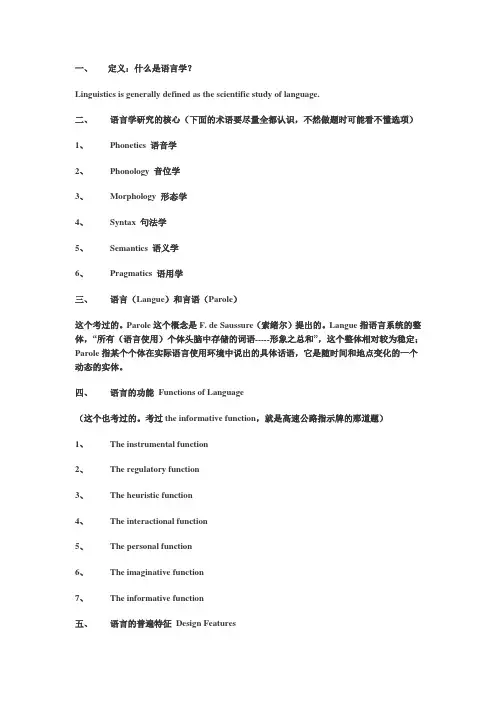
一、定义:什么是语言学?Linguistics is generally defined as the scientific study of language.二、语言学研究的核心(下面的术语要尽量全都认识,不然做题时可能看不懂选项)1、Phonetics 语音学2、Phonology 音位学3、Morphology 形态学4、Syntax 句法学5、Semantics 语义学6、Pragmatics 语用学三、语言(Langue)和言语(Parole)这个考过的。
Parole这个概念是F. de Saussure(索绪尔)提出的。
Langue指语言系统的整体,“所有(语言使用)个体头脑中存储的词语-----形象之总和”,这个整体相对较为稳定;Parole指某个个体在实际语言使用环境中说出的具体话语,它是随时间和地点变化的一个动态的实体。
四、语言的功能Functions of Language(这个也考过的。
考过the informative function,就是高速公路指示牌的那道题)1、The instrumental function2、The regulatory function3、The heuristic function4、The interactional function5、The personal function6、The imaginative function7、The informative function五、语言的普遍特征Design Features这个也考过的,这五个特征由美国语言学家Charles Hockett提出。
弱弱地说一句:如果真的在临时抱佛脚,那就不要管这五个术语的具体含义了,只要能强行记下来应付考试就是了。
>_<1、Arbitrariness 任意性2、Productivity 多产性3、Duality 双层结构4、Displacement 移位性5、Cultural Transmission 文化传播性六、语音学和音位学(一)语音学Phonetics: the study of the phonic medium of language.1、三大分支(1)Articulatory Phonetics发音语音学(2)Auditory Phonetics 听觉语音学(3)Acoustic Phonetics 声学语音学2、辅音和元音(这个考过的,考过二者的区别)(二)音位学Phonology: aims to discover how speech sounds in a language form pattern and how these sounds are used to convey meaning in linguistic communication.1、三个术语(1)Phone音素(2)Phoneme音位(3)Allophone音位变体2、Suprasegmental Phonology超音段音位(考过的)包括Stress重音、Tone音调、Intonation语调七、形态学Morphology: refers to the study of the internal structure of words, and the rules by which words are formed.(一)两类词汇1、Closed class words封闭性词汇2、Open class words开放性词汇(二)Morpheme词素1、Free morpheme自由词素2、Bound morpheme粘着词素3、Stem词干4、Root词根(三)Word-formation构词法(四)Inflection屈折变化八、句法学Syntax: studies how words are combined to form sentences and the rules that govern the formation of sentences.九、语义学Semantics: is generally considered to be the study of meaning in language.1、Synonymy同义关系2、Polysemy一词多义3、Homophones同音异义&Homogragh同形异义&Complete homonyms同形同音异义4、Hyponymy上下义关系5、Antonymy反义关系6、Analysis of meaning语义分析(1)Componential analysis成分分析(2)Predication analysis述谓分析7、 Two-place predicate二向谓词、one-place predicate一向谓词、no-place predicate 零向谓词8、 Sense relations between sentences(1)Entailment(2)Presupposition十、语用学1、Pragmatics: the study of how speakers of a language use sentences to effect successful communication. (Or it refers to the study of natural language understanding, and specifically the study of how context influences the interpretation of meanings.)2、区分语义学和语用学的最本质因素是:是否考虑了语言使用过程中的语境。

1、语言的定义:(广义语言与狭义语言的区分)狭义语言:说话所用的符号系统,人类用于交际和思维的最重要的符号系统;广义语言:说的动作+说所采用的一套符号系统+说出来的东西语言的功能:⑴语言的社会功能:语言是人类最重要的交际工具;语言是集体的标志;语言是社会生活的记录⑵语言的思维功能:语言是认知的伴侣;语言是思维的重要工具;语言是信息的载体。
语言演变的原因(一)社会因素的影响(外部因素)1.社会的进步。
社会进步,出现新事物或现象,语言中的语汇必须及时作出反馈。
同时语义系统也会对社会的进步作出反应。
2.社会的分化和统一。
社会的分化和统一会带来语言的分化和统一。
3.社会之间的接触。
也会推动语言的发展演变。
(二)心理因素的影响(外部因素)类推心理是影响语言发展变化的一种重要的思维惯性。
如,在先秦汉语中,动宾关系的一般语序是动词在前,宾语在后,但在否定句和疑问句中,代词宾语要前置,后来,这种非正常的语序受到正常语序的类推力的影响,也变为正常语序了。
(三)语言结构要素的相互影响(内部因素)语言必须能利用自身的形式手段把不同的意义区别开来,达到表意的明确性。
为适应这一要求,语言系统的各组成部分及其内部各成分分工合作,构成一个严密的系统,共同担负区别意义的职责,使语言能够发挥交际工具的作用。
如果某个因素发生了变化,使原有的分工遭到破坏,影响了表意的明确性,语言中的其他有关部分就会相应地发生变化,以重新调整它们之间的分工,恢复不同的语言形式之间的有效区别,消除表意不清的现象。
语言发展演变的特点(一)渐变性语言的交际工具的属性决定了不可能出现突变式的发展,也不可能出现很频繁的变化。
215个常用词(其中主要是基本词)在一千年中的发展变化情况:汉语和法语79%未发生变化,英语、西班牙语、意大利语85%未发生变化,德语78%未发生变化,罗马尼亚语77%未发生变化,葡萄牙语82%未发生变化。
“将、把、了”这几个实词虚化的过程大约用了上千年的时间。
语言学导论1章导论一、语言学的定义科学或系统学习语言,这始终是由三经科学指导性,一致性和经济。
二。
语言学与传统语法语言学不同于传统语法,至少有三种基本方法。
1。
语言学描述语言并没有制定正确的规则。
2。
语言学把口语作为主要的,而不是书面的。
3。
语言学对每一种语言都有其自身的优点。
语言学的范畴微观语言学:语音;语音;形态学;语法;语义;语用学宏观语言学:sociolinguitics;心理语言学;神经语言学;文体学;话语分析;计算语言学;认知语言学;应用语言学语言的定义语言是人类交际中使用的任意性的语音符号系统。
五、语言的起源鼎东理论:人的语言从原始人的声音表达到他所遇到的对象。
唱歌理论:语言从原始的仪式歌曲的赞美。
呸呸说:语言是感叹词,表达说话人的情感。
哟何理论:语言是从发出的呼声,在工作期间。
助教理论:语言是从某些手势和舌头运动的结合中产生的。
弓哇理论:语言来自模仿动物的叫声和其他声音在自然中听到。
六、语言的结构特征1。
任意性:这是指没有逻辑或内在特定的声音和意义,它是与之间的连接。
2。
二元性:语言在2个层次上运作。
在一个层面上,这些元素本身没有意义,但在另一个层次上结合起来,构成了另一个层次,这就意味着。
3。
生产力:生产力或创造力是指人的语言能力,使他能够产生和理解一个无限大量的句子在我们的母语。
4。
互换:互换性和互惠性是指人能够产生和接收的信息,和他作为一个演讲者和听众可以交换安心的角色。
5。
位移:位移是一种语言的特性,使人们可以在空间或时间上谈论事情的遥远。
6。
专业化:专业化指的是,人在沟通的过程中没有完全的身体参与。
7。
文化传播:语言是文化传播的。
它不能通过遗传传递。
七。
语言功能1。
交际功能/交流:语言是用来建立一个气氛或保持说话人和听话人之间的社会联系。
问候、告别和天气服务这一功能的评论。
2。
指令功能:语言是用来让听话人做某事。
最重要的句子是这个函数。
3。
信息功能:语言是用来告诉一些东西,给信息,或是对事物的原因。
语言学(linguistics)是以人类语言为研究对象的学科,探索范围包括语言的性质、功能、结构、运用和历史发展,以及其他与语言有关的问题。
语言学研究的对象是客观存在的语言事实。
不管是现代的语言还是古代的语言,都是客观存在的语言现象。
尽管不同话语表达的意义是带有主观性的和千差万别的,但是传递出来的语言信息却是能被别人共同理解的,语言学被普遍定义为对语言的一种科学化、系统化的理论研究。
并且语言是人类最重要的交际工具,是思想的直接现实。
《语言学教程》重难点学习提示第一章语言的性质语言的定义:语言的基本特征(任意性、二重性、多产性、移位、文化传递和互换性);语言的功能(寒暄、指令、提供信息、询问、表达主观感情、唤起对方的感情和言语行为);语言的起源(神授说,人造说,进化说)等。
第二章语言学语言学定义;研究语言的四大原则(穷尽、一致、简洁、客观);语言学的基本概念(口语与书面语、共时与历时、语言与言学、语言能力与言行运用、语言潜势与语言行为);普通语言学的分支(语音、音位、语法、句法、语义);;语言学的应用(语言学与语言教学、语言与社会、语言与文字、语言与心理学、人类语言学、神经语言学、数理语言学、计算语言学)等。
第三章语音学发音器官的英文名称;英语辅音的发音部位和发音方法;语音学的定义;发音语音学;听觉语音学;声学语音学;元音及辅音的分类;严式与宽式标音等。
第四章音位学音位理论;最小对立体;自由变异;互补分布;语音的相似性;区别性特征;超语段音位学;音节;重音(词重音、句子重音、音高和语调)等。
第五章词法学词法的定义;曲折词与派生词;构词法(合成与派生);词素的定义;词素变体;自由词素;粘着词素(词根,词缀和词干)等。
第六章词汇学词的定义;语法词与词汇词;变词与不变词;封闭词与开放词;词的辨认;习语与搭配。
第七章句法句法的定义;句法关系;结构;成分;直接成分分析法;并列结构与从属结构;句子成分;范畴(性,数,格);一致;短语,从句,句子扩展等。
第八章语义学语义的定义;语义的有关理论;意义种类(传统、功能、语用);里奇的语义分类;词汇意义关系(同义、反义、下义);句子语义关系。
第九章语言变化语言的发展变化(词汇变化、语音书写文字、语法变化、语义变化);第十章语言、思维与文化语言与文化的定义;萨丕尔-沃夫假说;语言与思维的关系;语言与文化的关系;中西文化的异同。
第十一章语用学语用学的定义;语义学与语用学的区别;语境与意义;言语行为理论(言内行为、言外行为和言后行为);合作原则。
语言languageLanguage is a system of arbitrary vocal symbols used by social group for communication.Arbitrariness: the forms of linguistic signs bear no natural relationship to their meaning.Productivity:language is resourceful because of its duality and its reclusiveness. We can use it to create new meanings.Duality:the property of having two levels of structures, such that units of the primary level are composed of element of the secondary level and each of the two levels has its own principles of organization. Displacement:human languages enable their users to symbolize objects, events and concepts which are not present(in time and spare) at the movement of communication.Cultural transmission:language is not genetically inherited. Passed from generation to generation, it requires some learning. It is true human are born with language capacity, but a particular language a person learns to speak is a cultural one, rather than a genetic one like the dogs’barking system.Interchangeability:any human being can be both a producer and receiver of messages.Language function:informative: language is the instrument of thought, record the facts. The use of language to record the facts is a prerequisite of social development.Interpersonal: by far the most important sociological use of language, and by which people establish and maintain their status in a society. Performative: the performative function of language is primarily to change the social status of personsEmotive: to change the emotional status of an audience for or against someone or something.Phatic communion: we all use such small, seemingly meaningless expressions to maintain a comfortable relationship between people without involving any factual contents.Recreational: the recreational function of a language is often overlooked because it seems so restrictive in purpose and supposedly so limited in usefulness.Metalingual: our language can be used to talk about itself. Sociolinguistics—the study of language with reference to society. Psycholinguistics---the study of language with reference to the working of the mind.Applied linguistics---the application of linguistic principles and theories to language teaching and learning.Important distinctions in linguistics: 规定性Prescriptive .描述性Descriptive /8.共时语言学Synchronical linguistics 7.历时语言学Diachronic linguistics /5.语言能力Competence 6.语言运用performance /9.语言langue 10.言语parole /speech, writing/ traditional grammar and modern linguistics第二章音系学1 Phonologyis the study of the sound patterns and sound systems of languages. It aims to discover the principles that govern the way sounds are organized in languages, and to explain the variations that occur.2 international phonetic alphabetA set of standard phonetic symbols in the form of a chart, designed by the international phonetic association since 1888. It has been revised from time to time to include new discoveries and changes in phonetic theory and practice.3 consonants and vowelsConsonant are produced by a closure in the vocal tract, or by a narrowing, which is so marked that air can not escape without producing audible friction.Vowel is produced without such stricture so that air escapes in a relatively unimpeded way through the mouth or nose.4 cardinal vowelAre a set of vowel qualities arbitrarily defined, fixed and unchanging, intended to provide a frame of reference for the description of the actual vowels of existing language.5 anticipatory and perseverative co-articulationwhen such simultaneous or overlapping articulation are involved, we call the process co-articulation.If the sound becomes more like the following sound, it is known as anticipatory co-articulation. If the sound shows the influence of the proceeding sound,it is perseverative co-articulation.6PhonemeThe smallest of sound which can distinguish two words7AllophonesDifferent phones which can represent a phoneme in different environments are called the allophones of that phoneme.8Minimal pairAre two words in a language which differ from each other by only one distinctive sound and which also differ in meaning.9free variationif two sounds occurring in the same environment do not contrast, that is the substitution of one for the other does not produce a different word form, but merely a different pronunciation of the same word, then the two words are in free variation.Chapter three 词汇学The total number of words stored in the brain is called the lexicon. Words are the smallest free units of language that unite sounds with meaning.Word :A unit of expression that has universal intuitive recognition by native speakers, whether it is expressed in spoken or written form. Lexeme: the abstract unit underlying the smallest unit in the lexical system of a language, which appears in different grammatical contexts. Grammatical/Functional words: express grammatical meanings, such as conjunctions, prepositions, articles, pronouns.Lexical/content words: have lexical meanings, those which refer to substance, action and quality, such as nouns, verbs, adjectives, and adverbs.Open-class words: a word group whose membership is in principle in finite or unlimited. New members can be added.Closed-class words: a word group whose membership is fixed or limited, new members are not regularly added.Morphology; the study of word formation, the internal structure of words, and the rules by which words are formed.Morphemes: the smallest unit language in terms of relationship between expression and content, a unit that cannot be further divided into smaller units without destroying or drastically altering the meaning, whether it is lexical or grammatical.Free morphemes: those that may constitute words by themselves.Bound morphemes;those that can not occur aloneRoot: the base form of a word that cannot be further analyzed without total loss of identity. It is that part of a word-form that remains when all the inflectional affixes and derivational affixes have been removed.Affix: the types of formative/morpheme that can be used only when added to another morpheme.Base: any form to which affixes of any kind can be added; a form to which a rule of word formation is applied.Stem: the part of the word form which remains when all inflectional affixes have been removed.Inflection: indicates grammatical relations by adding inflectional affixes.Derivation: combination of an existing word and an affix to form a new word.Compounding/composition is word-formation process consisting of joining two or more bases to form a new unit, a compound word-An Introduction to Modern Linguistics.Endocentric: one element serves as the head, of same syntactic class as the whole the relationship of ‘a kind of’.Exocentric: there is no head, no elements is of the same syntactic class as the whole, so not a relationship of ‘a kind of ‘something. Derivation: is also called ‘affixation’. It is the morphological process whereby grammatical of lexical information is added to the base. Conversion: is a word-formation process by which a word is altered from one part of speech to anther without the addition or deletion of any morpheme.Allomorph: some morphemes have a single form in all contexts. But a morpheme may have considerable variations, alternate shapes or phonetic forms called the allomorph.Blending: a process of word-information in which a new word is formed by combining the meanings and sounds of two words, one of which is not in its full form or both of which are not in their full forms.Back-formation: a shorter word is derived by deleting an imagined affix from a longer form already in the language.Acronym: words formed from the initial letters of the name of an organization or scientific term, etc. it differs from initialisms in that they are pronounced as words rather than as sequence of letter. Initialism: a type of shortening, using the first letter of words to form a proper name, a technical term, or phrase; an initialism is pronounced letter by letter.Analogical creation: It can account for the coexistence of two forms, regular and irregular, I the conjugation of some English verbs. Loanwords: both form and meaning are borrowed with only a slight adaptation.Loanblend: part of the form is native and part is borrowed, but the meaning is fully borrowed.Chapter 4 syntaxSyntax: the study of the rules governing the way words are combined to form sentences in a language, or simply the study of the formation of sentences.Category: the term category in some approaches refers to classes and functions in its narrow sense. More specifically, it refers to the defining properties of these general units.Phrase: is a single element of structure containing more than one word, and lacking the subject-predicate structure typical of clause.Word group is an extension of word of a particular class by way of modification with its main features of the class unchanged.Clause: a constituent with its own subjects and predicate when it is included in a lager sentence.Syntagmatic is a relation between one item and others in a sequence or between elements which are all present.Paradigmatic relation refers to classes or sets of words substitutable for each other grammatically in sentences with the same structure. grammatical construction; any syntactic construct which is assigned one or more conventional functions in a language, together with whatever is linguistically conventionalized about its contribution to the meaning or use the construct contains.constituent is a term used in structural sentence analysis for every linguistic unit, which is a part of a larger linguistic unit. Several constituents together form a construction.An endocentric construction is one whose distribution is functionally equivalent to one of its constituents, which serves as the center or head of the whole.Exocentric construction refers to a group of syntactically related words where none of the words is functionally equivalent to the group as a whole, that is, there is no definable “Centre”or “Head”inside the group, usually including the basic sentence, the prepositional phrase, the predicate construction, and the connective construction.Subordinate construction those in which there is only one head, with the head being dominant and the other constituents dependent,Coordinate construction:there are more than one head, the head can stand for the original construction functionally.Deep structure: the abstract representation of the syntactic properties of a constructionSurface structure: the final stage in syntactic derivation of a construction.Chapter five SemanticsDenotation involves the relationship between a linguistic unit and the non-linguistic entities to which it refers. Thus it is equivalent to referential meaning.Connotation-opposite to denotation, means the properties of the entity a word denotes.Sense be defined as the semantics relations between one word and another, or more generally between the one linguistic unit and another. Reference: is concerned with the relation between a word and the thing it refers to , or more generally between a linguistic unit andnon-linguistic entity it refers to.Synonymy-refers to the sameness or close similarity of meaning Antonymy-oppositeness of meaning.Complementary antonymy-the denial of one member of the pair implies the assertion of the other.Converse/reversal antonyms/relational opposites-exhibits the reversal of the relationship between the two items, one presupposes the other. Hyponymy上下义-inclusiveness, a relation ofinclusion Compositionality-the idea that the meaning of a sentence depends on the meaning of the constitute words and the way they are combined-the principle of compositionality.Polysemy一次多义-the same one word may have more than one meaning. Homonymy同音同形异义-the phenomenon that words having different meaning have the same form.Conceptual meaning-leech defined as the logical, cognitive, or denotative content. In other words, it overlaps to a large extent with the notion of reference.Linguistic semantics-the study of the meaning of linguistic units, words and sentences in particularPropositional logic-it is also know as propositional calculus or sentential calculus, is the study of the truth conditions for propositions Proposition-is expressed by a declarative sentence when that sentence is uttered to make a statement.Welcome !!! 欢迎您的下载,资料仅供参考!。